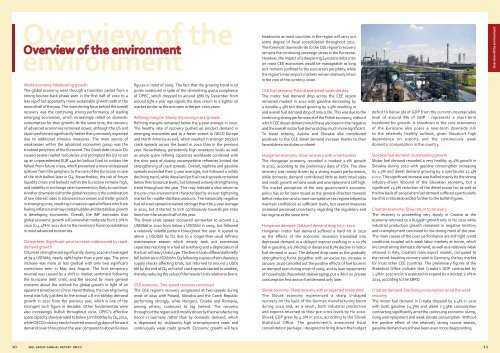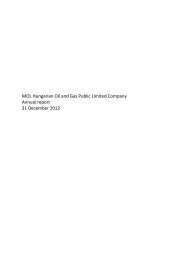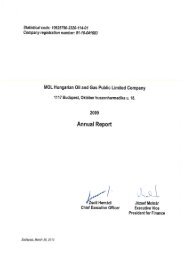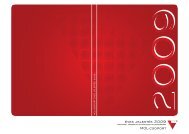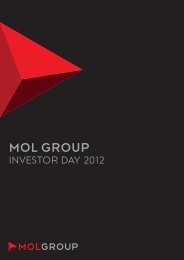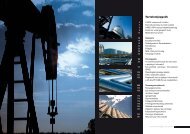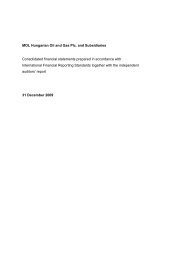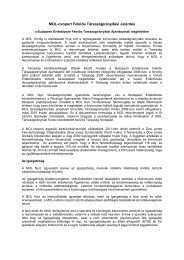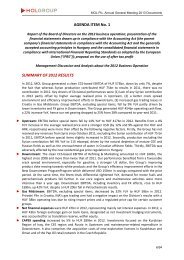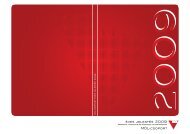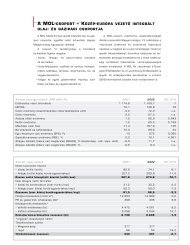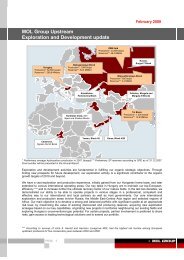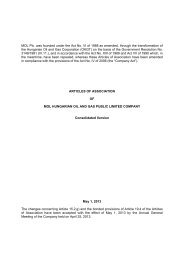MOL GROUP Annual Report
MOL GROUP Annual Report
MOL GROUP Annual Report
- No tags were found...
You also want an ePaper? Increase the reach of your titles
YUMPU automatically turns print PDFs into web optimized ePapers that Google loves.
Overview of the environmentWorld economy: Moderating growthThe global economy went through a transition period from astrong bounce-back phase seen in the first half of 2010 to aless rapid but apparently more sustainable growth path in thesecond half of the year. The main driving force behind the overallrecovery was the continuing strong performance of leadingemerging economies, which increasingly relied on domesticconsumption for their growth. At the same time, the recoveryof advanced economies remained slower, although the US andJapan performed significantly better than previously expecteddue to additional stimulus measures. The main source ofweaknesses within the advanced economies group was thetroubled periphery of the Eurozone. The Greek debt crisis in Q2caused severe market turbulence and prompted the EU to setup an unprecedented EUR 440 bn bailout fund to contain thefallout from future crises, which prevented a more widespreadspillover from the periphery to the core of the Eurozone in caseof the Irish bailout later in Q4. Nevertheless, the risk of futureliquidity crises and bailouts within the Eurozone remains high,and volatility in exchange rate movements is likely to continue.Another downside risk to the global recovery is the combinationof low interest rates in advanced economies and stellar growthin emerging ones, resulting in massive capital inflows which arefueling inflation and may create bubbles and destabilize growthin developing economies. Overall, the IMF estimates thatglobal economic growth will somewhat moderate from 5.0% in2010 to 4.4% in 2011 due to the necessary fiscal consolidationin most advanced economies.Oil markets: Significant price increase underscored by rapiddemand growthOil prices strengthened significantly during 2010 and averagedat 79.5 USD/bbl, nearly 29% higher than a year ago. The priceincrease was more or less gradual with only two significantcorrections seen in May and August. The first temporaryreversal was caused by a shift in market sentiment followingthe Eurozone debt crisis, and the second by more generalconcerns about the outlook for global growth in light of anapparent slowdown in China. Nevertheless, the overall growingtrend was fully justified by the annual 2.8 mn bbl/day demandgrowth in 2010 from the previous year, which is one of thestrongest such figure in decades. Other fundamentals werealso increasingly bullish throughout 2010. OPEC’s effectivespare capacity slowly eroded to below 5 mn bbl/day by Q4 2010,while OECD industry stocks hovered around 59 days of forwarddemand cover throughout the year compared to above 60 daysfigures in most of 2009. The fact that the growing trend in oilprices continued in spite of the diminishing quota complianceof OPEC, which dropped to around 58% by December fromaround 63% a year ago signals the slow return to a tighter oilmarket similar to the one seen in the pre-crisis years.Refining margins: Slowly improving crack spreadsRefining margins remained below the 5-year average in 2010.The healthy rate of recovery pushed up product demand inemerging economies and to a lesser extent in OECD Europeand North America as well, which resulted in stronger productcrack spreads across the board in 2010 than in the previousyear. Nevertheless, persistently high inventory levels as wellas ample spare refining capacities worldwide combined withthe slow pace of closing uncompetitive refineries limited thestrengthening of crack spreads. Overall, naphtha and gasolinespreads exceeded their 5-year averages, but followed a mildlydeclining trend, while diesel and jet fuel crack spreads remainedbelow their historical levels, but followed a slowly strengtheningtrend throughout the year. This may indicate a slow return tothe pre-crisis environment characterized by an ever tighteningmarket for middle-distillate products. The historically negativefuel oil crack spread remained stronger than the 5-year averagein 2010, but it started to inch continuously towards pre-crisislows from the second half of the year.The Brent-Urals spread recovered somewhat to around 1.4USD/bbl in 2010 from below 1 USD/bbl in 2009, but followeda relatively volatile pattern throughout the year. It soared toabove 3 USD/bbl by Q2 due to a longer-than-usual refinerymaintenance season which mostly took out conversioncapacities resulting in a fuel oil overhang and a depreciation ofthe fuel-oil heavy Urals type. The Brent-Urals differential brieflyfell below zero USD/bbl in Q3 following a series of simultaneoussupply shocks affecting Urals, but returned to around 2 USD/bbl by the end of Q4 as fuel oil crack spreads started to weaken,thereby reducing the value of the heavier Urals relative to Brent.CEE economy: Two-speed recovery continuedThe CEE region’s recovery progressed at two-speeds duringmost of 2010 with Poland, Slovakia and the Czech Republicperforming strongly, while Hungary, Croatia and Romania,among others, continued to lag behind. The recoverythroughout the region is still mostly driven by the manufacturingboom in Germany rather than by domestic demand, whichis depressed by stubbornly-high unemployment rates andcontinuously weak credit growth. Economic growth will faceheadwinds as most countries in the region will carry outsome degree of fiscal consolidation throughout 2011.The foremost downside risk to the CEE region’s recoveryremains the continuing sovereign stress in the Eurozone.However, the impact of a deepening Eurozone debt crisison most CEE economies would be manageable as longas it remains confined to the euro area’s periphery, whilethe region’s main export markets remain relatively intactin the core of the currency union.CEE fuel demand: Poland and diesel saves the dayThe motor fuel demand drop across the CEE regionremained modest in 2010 with gasoline decreasing bya notable 4.9% but diesel growing by 1.9% resulting inand overall fuel demand drop of only 0.1%. This was due to thecontinuing strong performance of the Polish economy, withoutwhich CEE diesel demand would have also been in the negativeand the overall motor fuel demand drop much more significant.To lesser extents, Austria and Slovakia also contributedpositively to the CEE diesel demand increase thanks to theirfavorable excise duties on diesel.Hungarian economy: Slow recovery with uncertaintiesThe Hungarian economy recorded a modest 1.2% growthin 2010, according to the preliminary data of KSH. The slowrecovery was mainly driven by a strong export performance,while domestic demand contributed little as both retail salesand credit growth remains weak and unemployment still high.The market perception of the new government’s economicpolicy has so far been mixed as the general direction towardsdeficit reduction and a more competitive tax regime helped tomaintain confidence at sufficient levels, but several measuresincreased perceived uncertainty regarding the regulatory andtax regime at the same time.Hungarian demand: Delayed demand drop hit in 2010Hungarian motor fuel demand suffered a hard hit in 2010as the effects of the economic recession translated intodepressed demand in a delayed manner resulting in a 12.7%fall in gasoline, a 6.7% drop in diesel and 8.7% decline in motorfuel demand in 2010. The delayed drop came as the graduallystrengthening forint (together with an excise tax increase inJanuary 2010) canceled out the positive effects of fuel tourismon demand seen during most of 2009, and as loan repaymentsof households (household deleveraging) put a dent on privateconsumption first and on fuel demand only later.Slovak economy: Sharp recovery with an expected moderationThe Slovak economy experienced a sharp V-shapedrecovery on the back of the German manufacturing boomduring 2010 and, as a result, both industrial productionand exports returned to their pre-crisis levels by H2 2010.Slovak GDP grew by 4.0% in 2010, according to the SlovakStatistical Office. The government’s announced fiscalconsolidation package - designed to bring down the budgetdeficit to below 3% of GDP from the current unsustainablelevel of around 8% of GDP - represents a short-termheadwind for growth. A slowdown in the core economiesof the Eurozone also poses a near-term downside riskto the relatively healthy outlook, given Slovakia’s highdependence on exports and the continuously weakdomestic consumption in the country.Slovakia fuel demand: Outstanding growthMotor fuel demand recorded a very healthy 15.4% growth inSlovakia during 2010 with gasoline consumption increasingby 1.5% and diesel demand growing by a spectacular 22.4%y-o-y. This significant increase was fuelled mainly by the strongindustry-driven rebound of the Slovakian economy, but asignificant 23.5% reduction of the diesel excise tax as well asthe low basis of 2009 (when fuel demand suffered a particularlyhard hit in Slovakia) added further to the bullish figures.Croatian economy: Slow return to recoveryThe recovery is proceeding very slowly in Croatia as theeconomy returned to a sluggish growth only in H2 2010 whileindustrial production growth remained in negative territoryand unemployment continued to rise during most of the year.The main causes of the poor performance are still tight creditconditions coupled with weak labor markets at home, whichare constraining domestic demand, as well as a relatively weakrebound in Italy, Croatia’s main export market, compared tothe record-breaking recovery seen in Germany, the key marketfor most other CEE countries. The preliminary figures of theStatistical Office indicate that Croatia’s GDP contracted by1.4% in 2010 and it is expected to expand by a modest 2.0% in2011, according to the EBRD.Croatian demand: Declining consumption amid the weakrecoveryThe motor fuel demand in Croatia dropped by 5.4% in 2010with both gasoline (-4.3%) and diesel (-5.9%) consumptioncontracting significantly amid the continuing economic slump,rising unemployment and weak private consumption. Withoutthe positive effect of the relatively strong tourist season,gasoline demand would have been even more disappointing.Overview of the environment10 <strong>MOL</strong> Group annual report 2010 11


